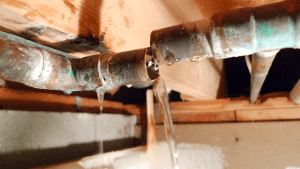Overview To Water Leakage Detection In Your Home
Overview To Water Leakage Detection In Your Home
Blog Article
Almost everyone will have his or her own theory when it comes to Hacks to detect leaks.

Early detection of dripping water lines can mitigate a possible catastrophe. Some little water leakages might not be noticeable.
1. Examine the Water Meter
Every house has a water meter. Examining it is a proven way that assists you find leaks. For starters, switch off all the water sources. Ensure nobody will purge, utilize the faucet, shower, run the washing machine or dish washer. From there, most likely to the meter and also watch if it will alter. Since nobody is utilizing it, there should be no movements. That suggests a fast-moving leak if it moves. If you find no modifications, wait an hour or 2 and examine back once more. This indicates you may have a sluggish leak that can even be below ground.
2. Inspect Water Intake
Examine your water costs as well as track your water consumption. As the one paying it, you must observe if there are any discrepancies. If you detect sudden changes, regardless of your intake being the same, it implies that you have leaks in your plumbing system. Keep in mind, your water expense need to drop under the same array each month. An unexpected spike in your expense suggests a fast-moving leak.
A constant increase every month, even with the same behaviors, reveals you have a sluggish leakage that's likewise gradually escalating. Call a plumber to extensively check your building, particularly if you feel a cozy location on your floor with piping underneath.
3. Do a Food Coloring Examination
When it concerns water consumption, 30% comes from commodes. Test to see if they are running appropriately. Decrease flecks of food color in the storage tank and wait 10 minutes. If the shade somehow infiltrates your bowl throughout that time without flushing, there's a leakage in between the storage tank as well as dish.
4. Asses Outside Lines
Don't neglect to inspect your outdoor water lines also. Test faucets by attaching a yard hose pipe. Must water seep out of the connection, you have a loose rubber gasket. Replace this as well as make sure all connections are limited. If you have actually obtained a sprinkler system, it will certainly help get it properly analyzed and also maintained every year. One tiny leak can lose lots of water as well as increase your water expense.
5. Inspect and also Examine the Situation
Homeowners need to make it a behavior to check under the sink counters as well as also inside cupboards for any bad odor or mold and mildew growth. These two red flags show a leak so timely focus is called for. Doing regular inspections, also bi-annually, can save you from a significant issue.
If you understand your house is currently old, maintain a watchful eye on your heaters, hoses, pipes and so on. Look for stainings and also compromising as many devices and pipes have a life span. They will additionally normally degrade as a result of damage. If you think leaking water lines in your plumbing system, don't await it to rise. Call a specialist plumber right away so you do not end up with a dreadful mess in your home.
Early discovery of leaking water lines can minimize a prospective calamity. Some small water leaks might not be visible. Checking it is a surefire means that aids you find leakages. One tiny leak can throw away loads of water as well as surge your water expense.
If you suspect leaking water lines in your plumbing system, don't wait for it to rise.
WARNING SIGNS OF WATER LEAKAGE BEHIND THE WALL
PERSISTENT MUSTY ODORS
As water slowly drips from a leaky pipe inside the wall, flooring and sheetrock stay damp and develop an odor similar to wet cardboard. It generates a musty smell that can help you find hidden leaks.
MOLD IN UNUSUAL AREAS
Mold usually grows in wet areas like kitchens, baths and laundry rooms. If you spot the stuff on walls or baseboards in other rooms of the house, it’s a good indicator of undetected water leaks.
STAINS THAT GROW
When mold thrives around a leaky pipe, it sometimes takes hold on the inside surface of the affected wall. A growing stain on otherwise clean sheetrock is often your sign of a hidden plumbing problem.
PEELING OR BUBBLING WALLPAPER / PAINT
This clue is easy to miss in rooms that don’t get much use. When you see wallpaper separating along seams or paint bubbling or flaking off the wall, blame sheetrock that stays wet because of an undetected leak.
BUCKLED CEILINGS AND STAINED FLOORS
If ceilings or floors in bathrooms, kitchens or laundry areas develop structural problems, don’t rule out constant damp inside the walls. Wet sheetrock can affect adjacent framing, flooring and ceilings.
https://www.servicemasterbyzaba.com/blog/how-to-detect-water-leakage-in-walls/

We were introduced to that write-up about Detecting hidden plumbing leaks through an acquaintance on our other web page. Sharing is good. You just don't know, you will be helping someone out. Thanks for your time spent reading it.
Report this page